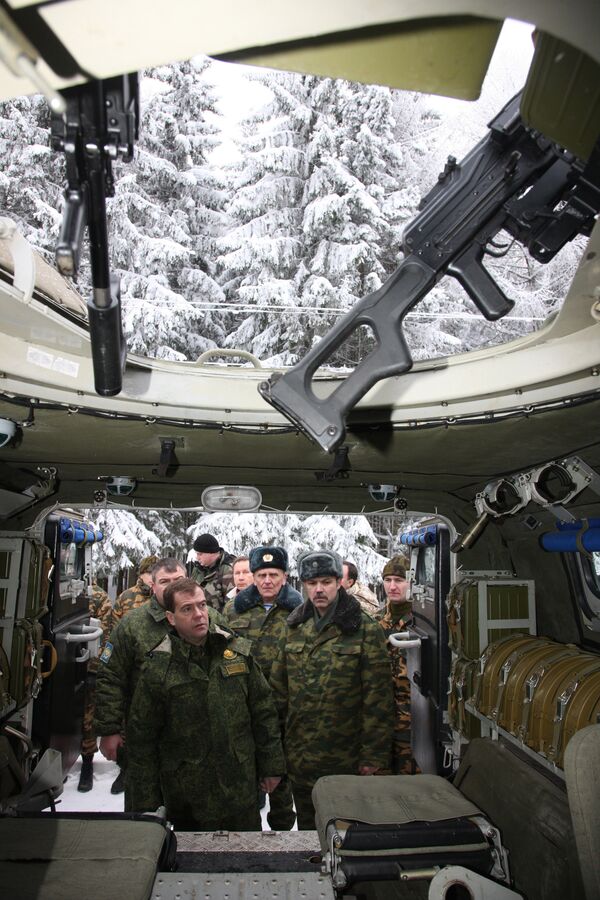Since 1993, February 23 has been known as the Defender of the Fatherland Day. In essence, however, it remains a day in honor of the army and navy, in full accordance with its original name: Day of the Soviet Army and Navy. It has been 20 years since the collapse of the U.S.S.R., but the country's military remain the holiday's main protagonist.
February 23 has taken on a special significance this year. Despite the radical political and economic reforms in the country between 1993 and 2009, the armed forces retained their Soviet structure and character. Military reforms were mostly limited to reductions in manpower and equipment and did not drastically affect the military's organizational structure.
This year things have changed completely. Since the fall of 2008, the military has been undergoing its most radical changes since the reforms initiated by Dmitry Milyutin in the second half of the 19th century. These reforms saw the introduction of such present-day elements of the armed forces' structure as military districts, conscription, the emergency mobilization reserve, etc.
The reform initiated by Anatoly Serdyukov is still far from complete, and it is difficult to envision the military's structure 15 to 20 years from now. Nevertheless, this is arguably one of the most important issues for the country, as building a military is a lengthy process, and a clear understanding of its future structure is necessary both for politicians and civilians.
This structure can be predicted based on the statements and actions of the country's military and political leadership. How do the people who are implementing the military reform envision the structure of the future Russian armed forces?
The publicly stated goal of the reform is to create a compact army of constant readiness, designed mainly to fight local and regional conflicts. At the same time, Russia will maintain its strategic nuclear forces as a safeguard in the event of a "big war." The country's nuclear capability should guarantee the possibility of inflicting unacceptable damage on any aggressor or coalition of aggressors.
According to the new, recently approved military doctrine, Russia reserves the right to launch a preemptive nuclear strike, if the aggressor (or coalition of aggressors) threatens the country's sovereignty and independence.
The armed forces' command hierarchy will be changed from the four-level, "military district-army-division-regiment" structure to a three-level, "military district-operational command-brigade" model. The brigade structure has been given preference to by the Defense Ministry, as it is more flexible and mobile compared to the division-based alternative.
Simultaneously, the officer corps will be reduced. Since the "mobilization plan," which would have provided for a sharp increase in manpower in case of war, is being abandoned, units comprised mainly of active officers with only a few soldiers under their command and bloated command structures can be eliminated. As a result, the officer corps will be sharply reduced, which will allow for officers' salaries to be increased.
At the same time, some elements of the mobilization plan will be preserved, including storage facilities for weapons and equipment and trained reserves. This will allow the military to arm additional troops relatively quickly, if necessary.
What weapons will the new armed forces have? The military's rearmament is a top priority for the country's leadership. "We must continue purchasing high tech military equipment, as prescribed in the Presidential Address, and procurements must be in line with the parameters that I have defined," said President Dmitry Medvedev when visiting the Vystrel training courses on January 14, 2010.
Vladimir Putin provided further details. "The amount of modern weaponry in the armed forces must account for at least 30% by 2015, and 70% by 2020. Toward this end, we should allocate the necessary financial resources," the Prime Minister declared on February 17, 2010.
The priority for new weapons systems will be given to the strategic nuclear forces, whose importance has been repeatedly acknowledged by the country's leadership. Nevertheless, almost all armed services will be supplied with new types of weaponry. Rearmament has been fairly low during the economic downturn, but as stated by the defense minister, the prime minister and the president, the military production will steadily increase as new weapons are tested and developed industrially, as well as with the end of the economic downturn.
"If we compare the amount of hardware ordered, 2010 would definitely be a breakthrough year. We have not purchased so many jets or helicopters since the last century. There is every reason to believe that state military procurements will not decrease, but, on the contrary, will continue to increase," Anatoly Serdyukov said in December 2009.
The opinions expressed in this article are the author's and do not necessarily represent those of RIA Novosti.
MOSCOW. (RIA Novosti military analyst Ilya Kramnik)



